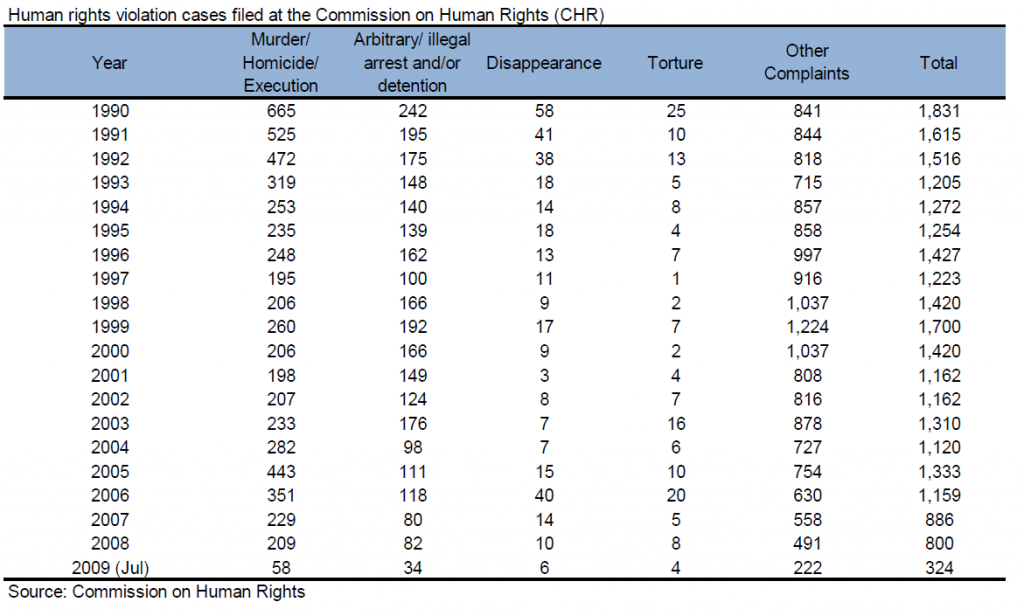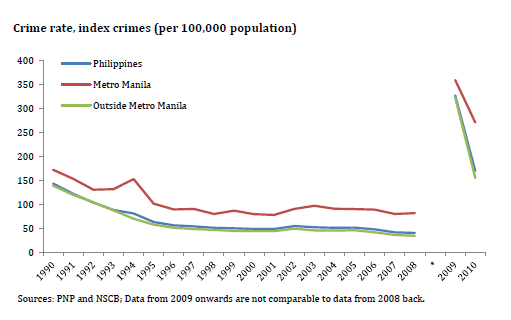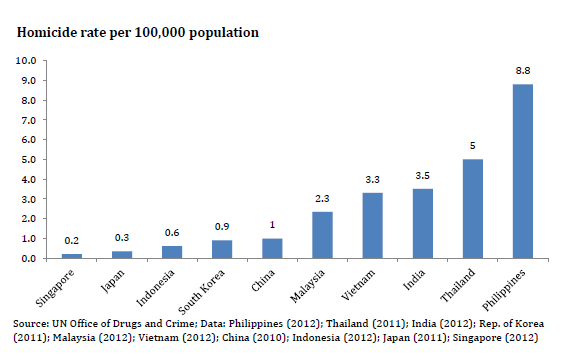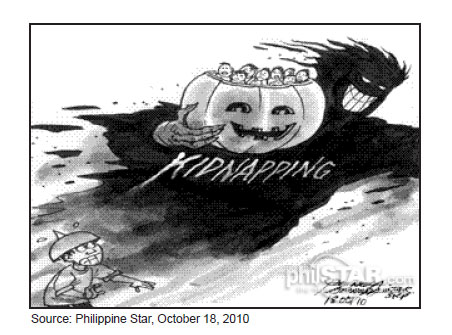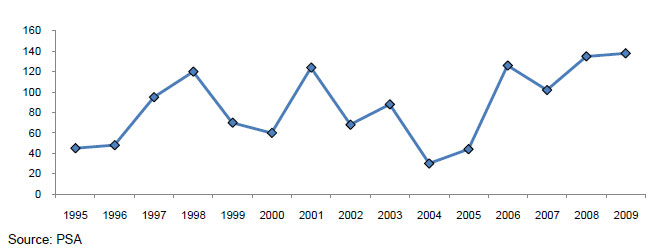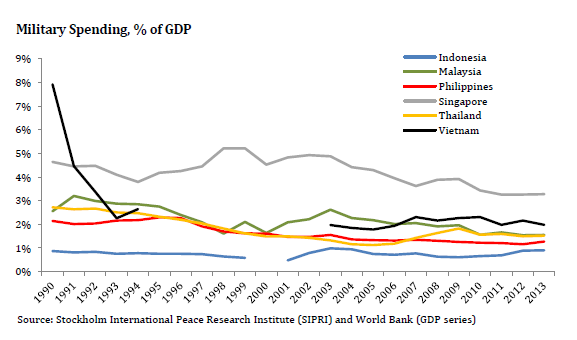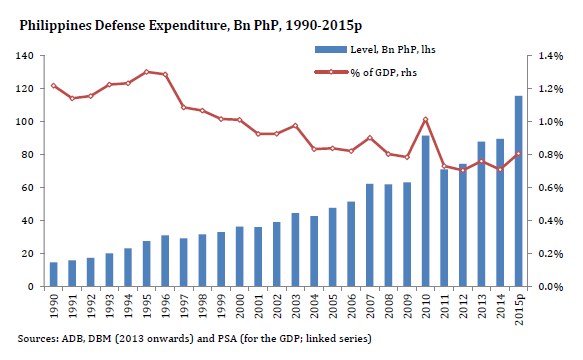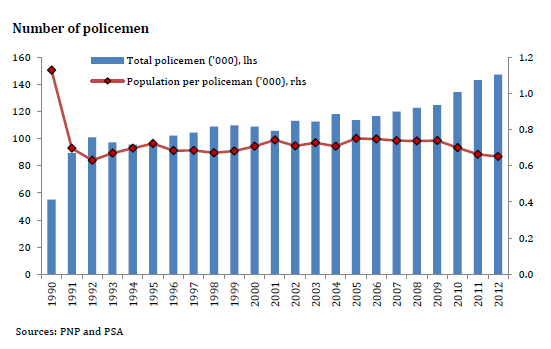Security
Security issues in the Philippines can be a serious concern for the investment climate, especially in some rural areas, for the mining and tourism sectors, and in parts of Mindanao. This section discusses several key areas of security: external security, internal security (insurgency, terrorism, and warlordism), military extra-constitutional actions, crime, defense and police capabilities of the government, and foreign government travel warnings.
• External security
The Philippines faces no external security threat in traditional military terms and has not experienced armed conflict involving foreign military forces in the country since WWII.
Southeast Asia has been free of major international military conflict since the end of the Second Indochinese War in 1975 and the Vietnamese invasion of Cambodia that overthrew the Pol Pot regime in early 1979, followed by heavy Chinese cross-border incursions into Vietnam. Vietnamese forces remained in Cambodia for a decade.
• Internal security
The World Bank measure Political stability and the absence of violence and terrorism shows the Philippines falling to the lowest ranking among the ASEAN-6 in the post-9/11 era. The Philippines, however, is in the company of Thailand and Indonesia; the three are ranked closely together. Thailand and Philippines have declined the most over the last decade, the result of 9/11 and continuing challenges from various armed elements and persistent criminal violence. Indonesia began the decade ranking the lowest and has since then improved. Ratings of the other three – Singapore, Malaysia, and Vietnam – have remained relatively steady (see Figure 220).
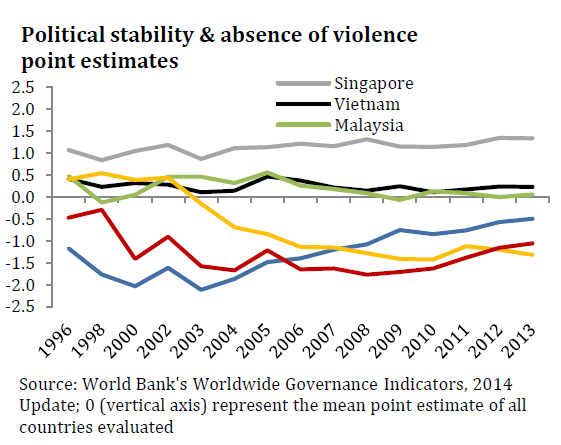
View original figure here
The above ranking clearly shows how badly the Philippine international image suffers from international media reports and Western government travel advisories that leave an overall impression of a land that is a battleground of terrorist activity and widespread mayhem and murder. But were this true, no tourists would visit and foreign businessmen and diplomats would have left the country. They have not left, but they do – and should – pay careful attention to personal security.
The threat of terrorism imposes costs on business operations, which are rated by the WEF in its Global Competitiveness Report. For the ASEAN-6 these are towards the higher end of the 139 countries ranked in 2010 (see Figure 221). For comparison, the US is ranked next to the Philippines at 125 and the United Kingdom at 99. In the Philippines, many private businesses employ private security guards and other security services, creating a business cost which would not be necessary if there were no terrorist activity, less crime, and better police protection.
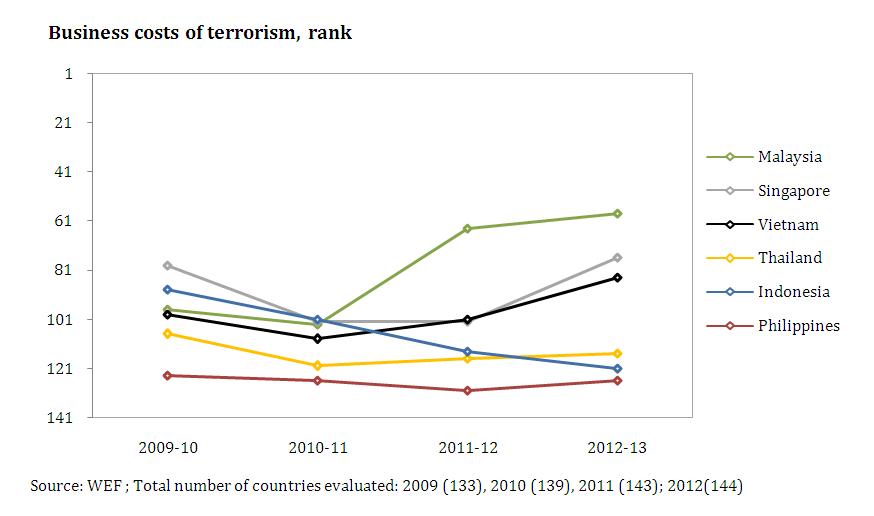
View original figure here
The Philippines faces internal security threats from the communist New People’s Army (NPA), which operates in most areas of the Philippines, the Moro Islamic Liberation Front (MILF), which is confined to Central Mindanao, and the Abu Sayyaf Group (ASG), operating in Basilan and Sulu provinces in south-western Mindanao.
The costs of the nation’s internal security problems over the last four decades have been enormous. Probably as many as 200,000 Filipinos – military and police, insurgents, and especially civilians – have lost their lives. Millions of persons have been temporarily and even permanently displaced as the result of fighting. The economic development of conflict-affected areas has long been neglected by both the public and private sectors, with the consequence that such areas remain among the poorest in the country. Among the 77 provinces, 12 of the 14 poorest are in Mindanao.
• Internal security: NPA
Founded in Tarlac in 1969, the NPA today numbers less than 10,000 – down significantly from its peak in the late-1980s. While in decline, the communist insurgency remains a security problem in scattered rural areas on all main islands in the archipelago. Deadly clashes with government forces are common. The NPA and its political action allies espouse an anachronistic communist economic ideology abandoned long ago by their former patrons in China. Often, local NPA guerillas are more bandits than ideological revolutionaries.
Despite a half-century of experience with communist insurgency, the Philippine government has failed to successfully implement a strategy combining steady military pressure on the NPA with economic and social justice for the rural poor. The Philippines in the 1950s, against the Hukbalahap, and Malaysia and Thailand in the 1960s, succeeded in defeating communist insurgencies with such strategies. Yet the Philippine government has had limited success during the 40-year long NPA insurgency. Former president Macapagal-Arroyo ordered the Armed Forces of the Philippines (AFP) to wipe out the NPA before the end of her term. An increase in military operations and assassinations of unarmed militants followed, but armed rebellion continues.
The government has negotiated sporadically since 1986 with leaders of the Communist Party of the Philippines (CPP)/National Democratic Front (NDF) without significant result, given extreme political demands by Philippine communists leaders who have lived for decades in exile in Europe. It is especially difficult to negotiate with an extremist political movement whose main objective is replacing the elected government.
• Internal security: MILF
The MILF armed political separatist movement is largely based in Maguindanao province. In 1981 it broke away from the Moro National Liberation Front (MNLF), which entered into a settlement with the GRP in 1996 ending its state of belligerency and creating the Autonomous Region of Muslim Mindanao (ARMM).
Like the NPA, the MILF leaders have been fighting the central government for 40 years, first seeking independence and, more recently, a greater degree of autonomy than is found in the ARMM. Malaysia has facilitated discussions between the government and the MILF leadership for over a decade, and a structure is in place with international observers that subdues the level of violence between the AFP and MILF armed groups. A ceasefire standoff has prevailed for 30 years, interrupted by brief periods of fighting, the worst initiated by former president Estrada, who in 2000 ordered an “all-out war” against the MILF. The campaign captured MILF camps and caused mass evacuation of civilians, then was followed by the return of the status quo ante.242
Former president Arroyo pursued a negotiated political settlement strategy. However, the GRP-MILF Memorandum of Agreement on Ancestral Domain agreed to in August 2008 was met with vitriolic political opposition, including an adverse Supreme Court ruling, and was withdrawn by the national government. Talks have not resumed since.
Like his predecessor, President Aquino hopes to achieve a negotiated political settlement during his term that is acceptable to a majority of Filipinos. But bringing lasting peace to the affected areas of Mindanao will not be easy. Settling this long-standing insurgency would improve the overall national Philippine image and could lead to increased investment and more economic growth in Mindanao.
• Internal security: ASG
The ASG is a radical Islamic separatist terrorist group operating since the 1990s from bases in Sulu and Jolo provinces. While its strength has declined to a few hundred, its periodic violent actions have greatly contributed to the image of Mindanao as highly dangerous.
A decade ago the ASG gained worldwide attention when it kidnapped European and American tourists from resorts in Sabah and Palawan. ASG also conducted fatal bombings in Manila and Mindanao, including sinking an inter-island ferry near Manila with 116 fatalities in the worst terrorist incident in the country. The ASG, which has partly financed itself with ransom money, has also been responsible for kidnapping Filipino and foreign journalists. The ASG is considered linked to Jemaah Islamiyah (JI), the Al Qaeda-supported group responsible for bombings in Indonesia that advocates a pan-Islamic state.
• Better infrastructure may help improve Mindanao’s security
Mindanao is one of the poorest yet most promising regions of the Philippines, where the presence of communist insurgents, private armies, and moderate and radical separatist groups have long created impediments to investment and development. Solutions involve (1) better governance and economic growth that will undermine the appeal of local combatants using a strategy of violence, (2) an implementable political settlement with the MILF, and (3) military/police action against the ASG.
A parallel path to a brighter future for Mindanao is to improve its infrastructure to support faster economic growth. Priorities include an end to the current serious power blackouts, much better air, ground, and sea transportation infrastructure, and less expensive freight costs for exports.
The national government has long been less responsive to Mindanao’s infrastructure development than for other regions, especially Manila. Several presidents have committed to bringing over 30% of national infrastructure funds to Mindanao but have not delivered. Mindanao should get more than its share considering past neglect, its size, population, role in food production, and strategic role in bringing peace and a reduction of terrorism to the country.
An updated Master Plan for Mindanao Infrastructure is needed but must be properly conceptualized, planned, supported, and implemented at a high level with help from a champion in Manila. A number of plans have been prepared, but a single plan that takes the best from each probably does not exist.243
The Mindanao Development Authority (MinDA) is preparing the 2020 Peace and Development Framework Plan for Mindanao for completion in late 2010, which contains an infrastructure section. This plan should address the very high cost of shipping and logistics for Mindanao products (see Part 3 Manufacturing and Logistics), prioritize the lists of all projects in the infrastructure subsectors, especially an integrated transportation network and power supply.
• Warlordism
The massacre in November 2009 in Ampatuan, Maguindanao of 57 persons shocked the world for its brutality, adding to the prevailing external image of the country as a lawless land. Thirty-four journalists died in the massacre, the worst attack on newsmen ever recorded, in a country already labeled as the most dangerous for journalists after Iraq.
The massacre also brought into public view the continuing problem of private armies of politicians in the Philippines. These were an issue before martial law; several hundred thousand weapons were collected and many private armies disbanded after 1972. In recent years, private armies have returned in some rural areas, where local politicians feel the need to protect themselves and intimidate opponents. These groups are responsible for much of the political killings that have long accompanied Philippines elections.
An Independent Commission on Private Armies appointed after the Maguindanao massacre reported that 72 private armed groups were active in May 2010 in nine provinces: Abra, Masbate, Nueva Ecija, Samar, Basilan, Maguindanao, Lanao del Norte, Lanao del Sur, and Sulu. The most active private armies were reportedly in the ARMM. The Commission recommended an Anti- Private Armies Act be passed and EO 194 of former president Estrada allowing civilians to own an unlimited number of firearms be rescinded. Also noted by the Commission were reported death squad and similar vigilante activities in Davao and several other cities.
• Military extra-constitutional actions
While the Philippine military was largely uninvolved in Philippine politics before 1972, its role as the enforcer of martial law until 1986 increased its internal power and introduced many senior officers to corruption. During the following quarter century there have been repeated incidents of political interference, usually by mid-ranking officers, some mistakenly termed “coups” but better called mutinies.
The two People Power revolts that forced former presidents Marcos and Estrada from office in 1986 and 2001, succeeded because the AFP withdrew support for the constitutional president and backed the demonstrating civilian opponents of the incumbent regime, presidential candidate Aquino in 1986 and Vice President Arroyo in 2001. Neither was a true “coup d’etat” in which military leaders turn against civilian government leaders, usually violently, to attempt to seize state power. There are many historical examples of successful coups in Asia, in Burma, Indonesia, Japan, Korea, Thailand, and Vietnam. However, a purely military coup d’etat has never succeeded in the Philippines.
The most serious attempted military coup in the Philippines occurred in December 1989, in a year when GDP growth reached 7 percent, and caused considerable harm to the economy by damaging business confidence. The July 2004 takeover of an apartment tower in Makati, the nation’s premier business district, by a small group of mutineers was an unwelcome reminder that ill-disciplined soldiers can be as disruptive to security as terrorists and guerillas. The leader of this group subsequently seized a leading hotel in November 2007, whose assault by government forces was broadcast live around the world.
President Arroyo faced incipient military disobedience in February 2006 from a Philippine Army Scout Ranger general and a decorated Philippine Marine colonel, who plotted a coup but were exposed, arrested, and were still imprisoned in May 2010, when each ran unsuccessfully for the Senate. Two former military rebels have been elected to the Senate, suggesting a degree of popular support for their actions.
The application of firmer discipline by the military against internal dissidence and the election of a highly-popular president in May 2010 have reduced the prospect for serious military coup plotting and actions. Corruption within the armed forces and high levels of civilian government have in past years motivated mid-level officers to attempt extra-constitutional actions. For a period after 1986, a Marcos loyalist faction in the military also maneuvered against his successor. The passage of time and prospects for improved national governance appear to have attenuated inclinations within the military to serious rebellion and the threat of recurrence, although mutinous incidents by small groups may yet occur.
“The Oakwood mutiny of July 2003 and the takeover of the Manila Peninsula in November 2007, both occurring smack in the central business district, portrayed the Philippines in a Wild, Wild West scenario and drove away considerable investments. (The coup attempt mounted by Honasan and his comrades in December 1989, also in Makati, resulted in financial loses anywhere between PhP 800 million and PhP 1 billion! And we’re not even talking about the body count.)”
—Editorial, Philippine Daily Inquirer, October 15, 2010
In the long-run, if the democratic system cannot meet the development needs of an exploding population, then the risk of greater political instability may increase, whether from an interventionist military, a resurgent guerilla movement, or both.
• Human rights violations
The Commission on Human Rights (CHR) is a constitutional body created under the 1987 Constitution. Its offices throughout the country record reports of serious illegal incidents believed to be political in nature, in which government persons or political opponents may be the suspected perpetrators. From the data in Table 82 below (1990-2009) it is clear the Philippines still has a high incidence of human rights complaints.
While investigated, few cases are brought to trial and few responsible parties are sentenced for their crimes. This lack of an effective system of justice has been commented on frequently by foreign governments, the UN, and international NGOs and remains an area that the nation should strive to improve to bring better rule of law to its citizens. The Ampatuan massacre is the worst incident, and it and the subsequent trial have received extensive international publicity. Until the guilty are punished, however, assassinations of journalists and political activists, judges and local officials, and others, will continue, with relative impunity.
• Crime
The Philippines has a serious crime problem. Poverty and joblessness create an incentive for petty crime which the average Filipino is very likely to encounter in his daily life. According to an SWS survey in 2008, almost 10 percent of respondents stated they had lost property or suffered physical violence in the previous six months. Government statistics as of 2008 measured the crime rate per 100,000 persons for the country at 0.074% (74 persons in every 100,000), while in Metro Manila it was twice as much at 0.155% (155 persons in every 100,000) (see Figure 222).
Crime and violence has a business cost, which is measured in the Global Competiveness Report, in which the Philippines ranks lowest, surprisingly alongside Malaysia (see Figure 223). The United States ranked 84.
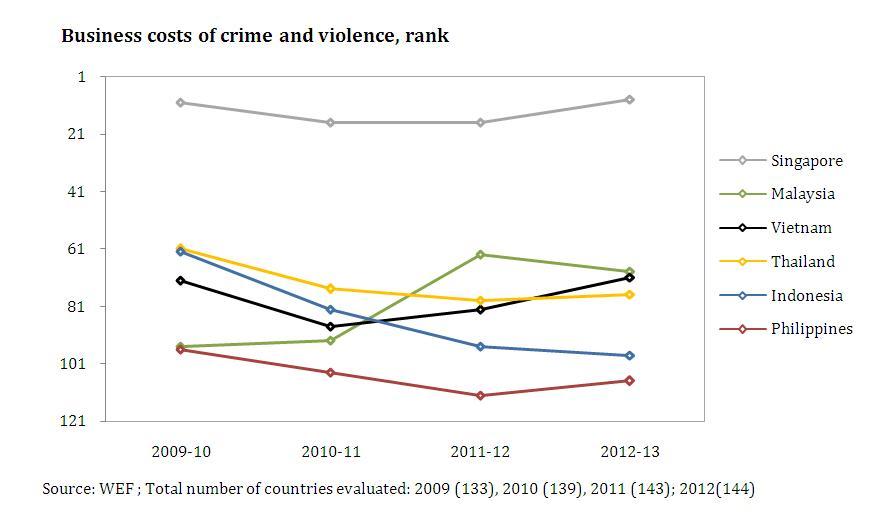
View original figure here
The prevalence of weapons also results in a high level of gun violence. Among the ASEAN-6+4, the Philippines has the highest murder rate, followed closely by Thailand (see Figure 224). The Philippine murder rate is three to 15 times higher than the other countries, except Thailand. There are an estimated 1.2 million unlicensed firearms in the country, contributing to the Philippine rank as number 10 worldwide for gun homicide. Despite the rise in political killings during elections, the gun ban that is generally enforced during campaigns results in lower levels of non-political gun-related violence.
Kidnapping for ransom, long a problem in the Philippines, has often victimized Filipino- Chinese, who reputedly pay large sums to be released and often do not report the crimes nor the ransom amount. Foreigners have also been kidnapped, most frequently by Islamic radicals and bandits in Mindanao. An unusual and sensational incident occurred in Manila in August 2010 when a busload of tourists from Hong Kong of several nationalities was seized by a disgruntled former policeman. The botched assault – broadcast live to the world – left eight dead and was a blow to the government’s tourism promotion plan.
The largest kidnapping incident involving Filipino terrorists was at Sipadan Island Resort, Malaysia in 2000 when the ASG seized 21 tourists from Germany, France, South Africa, Finland, Lebanon, Malaysia, and the Philippines, moving them to their base in Jolo. After surviving many months under harsh conditions, they were released upon the intervention of Libyan leader Gaddafi, US$ 25 million in “development aid,” and after military offensive. Such incidents have given the Philippines the reputation as the “Kidnap Capital of Asia.”
Data on kidnap incidents vary, as many are not reported. The government figures are considerably lower than those reported by the Citizens Action Against Crime (CAAC), an anti-kidnapping advocacy group organized by the Filipino-Chinese community. Figure 226 provides data that shows incidence of kidnapping since 1995, with the level in the last four years being consistently higher than average.
Most incidents (60%) occur in Mindanao and are perpetrated by terrorist groups. Kidnapping elsewhere is most often done by criminals interested in ransom. About 10 percent of the persons kidnapped in incidents reported in 2009 were killed.244 Periodically, the government mounts anti-kidnapping campaigns against suspect kidnap-for-ransom syndicates.
It is not surprising that the perception of the reliability of police services is ranked lower in the Philippines than the other ASEAN-6 countries (see Figure 227).
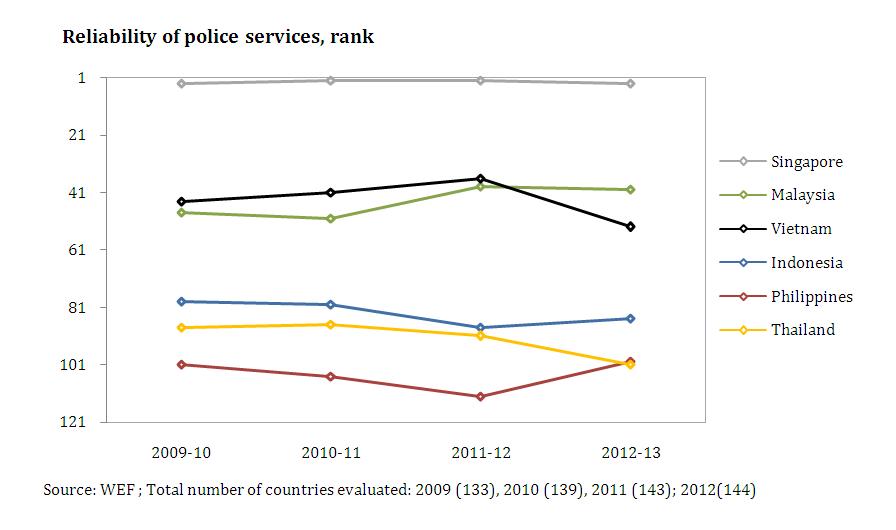
View original figure here
• Defense and police forces
In the absence of an external threat, the AFP has long given the highest priority to internal security, disaster relief, and search and rescue operations. Its total force strength of 106,000 is small for a country with a population of nearly 100 million. Funding for new equipment has been very limited for many years and certain missions, e.g. air defense or maritime patrol, are inadequately performed for lack of any jet fighters or maritime patrol aircraft.
The Philippines spends only 0.85% of GDP on its military, less than any ASEAN-6 country; this amount has slowly declined over the last 20 years (see Figures 228 and 229). A modernization program for the AFP, which started in the mid-1990s, has been very slow to use funds available for the procurement of new equipment.
“The need to modernize is most glaring in the PAF [Philippine Air Force], which is often described in jest as all air and no force…That situation would be laughable if it did not put public safety and national security at risk. The lack of a credible air defense capability means the Philippine military cannot effectively patrol the country’s territory and deter intruders, including poachers and foreign forces building structures on Philippine-claimed areas in the South China Sea…[D]efense requirements cannot be given low priority. Military capability is needed not just for fighting insurgents and terrorists but also for rescue and relief efforts…At his inaugural, President Aquino vowed to hire more military and police personnel to match the boom in the country’s population…Credible defense capability is a reasonable goal.”
—Editorial, Philippine Star, July 7, 2010
A modern, efficient police force is essential to improving the peace and safety conditions of the country. The current police force strength of 120,000 is too small for a country with a population of 100 mllion (see Figure 230). In 2008, there was just under one policeman for every 1,000 persons. Equipment for the police is poor, especially in rural areas.
• Foreign government travel advisories and warnings
A number of foreign governments, including Australia, Canada, the UK, and the US, issue travel advisories and warnings to their citizens on travel to the Philippines. Sometimes the warnings are geographically broad and use language that leads readers to avoid any travel to the country or the part of the country that is referred to in the warning. For example, the US often warns of the risks of travel to Mindanao. While no one would dispute that there are very dangerous parts of Mindanao, there are also quite safe areas, where criminal and terrorist activity has been no worse than Manila or Cebu.
“The State Department warns U.S. citizens of the risks of travel to the southern Philippine islands of Mindanao and the Sulu Archipelago, and urges extreme caution if traveling there.”
Website, US Department of State, Bureau of Consular Affairs, April 2, 2010
“There is a high threat from terrorism throughout the Philippines. Attacks could be indiscriminate, including in places frequented by expatriates and foreign travellers.” Around 70,000 British tourists visit the Philippines every year (Source: Philippine Ministry of Tourism). Most visits are trouble-free.
UK FCO, October 14, 2010
Headline Recommendations
- Improve political stability and reduce violence, terrorism, and human right abuses throughout the Philippines. Use different strategies to deal with the MILF, NPA, and ASG. Negotiate with the MILF and the NPA and use force to isolate/ eliminate the ASG.
- Reduce violence in Mindanao and increase economic development in the island’s poorest provinces. Develop and implement the Mindanao 2020 Peace and Development Plan, emphasizing better infrastructure and lower shipping costs. Reduce/eliminate warlordism. Expand CCT, Kalahli-CIDSS and other programs that reduce government neglect of population living in remote areas.
- Modernize the armed forces and police and increase their numbers. End extra-constitutional actions by any military units through reforms and discipline. Reduce crime, especially murders and kidnappings.
Recommendations: (15)
A. Improve the Philippine country rating in the World Bank measure Political stability and the absence of violence and terrorism, presently lowest among the ASEAN-6, to be ahead of Indonesia and Thailand. Also improve the Philippine country rating in the WEF category Business costs of terrorism, where the country is last among the ASEAN-6. (Medium-term action AFP, DILG, DOJ, LGUs, and private sector)
B. Minimize conflict in Mindanao with the MILF and negotiate a settlement agreement consistent with the Philippine Constitution and supported by the Congress and local communities in Mindanao. (Medium-term action OP, LGUs, Congress, and private sector)
C. Continue aggressive military action to contain and eliminate the ASG and minimize/prevent any presence of JI militants in the country. Maintain training and intelligence cooperation with friendly foreign military forces. (Immediate action DND, AFP, and LGUs)
D. Reduce poverty faster in the poorest provinces in Mindanao. Increase the national government allocation of resources to Mindanao to at least 30%. (Medium-term action NEDA, DSWD, DBM, DTI, DILG, LGUs, and private sector)
E. Complete and implement the Mindanao 2020 Peace and Development Plan containing a Master Plan for prioritized infrastructure projects that will provide reliable power supply, integrated road and port transportation, and less expensive transport costs to and from Mindanao. The Plan(s) must have a champion in Manila. (OP, MinDA, various departments, and private sector)
F. Warlordism, primarily in Mindanao, must be suppressed. An Anti-Private Armies Act should be passed. Local police and armed civilian auxiliary units should be better managed by the national government, so that they do not commit abuses and become “captured” by local warlord politicians. Over time the local auxiliaries should be reduced. (Medium-term action DILG, LGUs, AFP, DOJ, and Congress)
G. Hold talks and negotiate with Philippine communist political representatives and seek longer cease-fire periods but do not expect success in view of the historical goals of the CPP/ NPA. (Immediate action OP, DOJ, and DND)
H. To counter the appeal of the communists in rural areas, extend government services, including health and education, and improve infrastructure and livelihood programs. Increase the conditional cash transfer program. Better governance and economic growth will undermine the appeal of local combatants who use violence. (Medium term action DILG, DSWD, DPWH, DEPED, DOH, LGUs, and private sector)
I. Successfully investigate and prosecute human rights abuses in order to reduce such violations and improve the international image of the Philippines. Financial rewards for information leading to arrests should be adequate. The witness protection should be strengthened and applied effectively. The Ampatuan massacre trial, which is under close international scrutiny, must be conducted in an expeditious and legally correct manner and be a model of rule of law in the country. (DOJ and courts)
J. Implement defense modernization faster. The extensive Philippine coastal seas, vulnerable to smuggling of weapons, terrorists, and goods, need more patrol and interdiction activities by Philippine or regional patrol forces. (Long-term action DND, AFP, and DBM)
K. Increase the size of and better equip the national and local police forces. (Long-term action DBM, DILG, and LGUs)
L. End extra-constitutional actions by any military units through reducing military corruption, meeting equipment concerns especially in Mindanao, maintaining chain-of-command discipline, and promoting military professionalism. Court martial and otherwise deal firmly with all military mutinies. (DND, AFP, DBM, and DOJ)
M. Limit firearms in civilian hands and reduce loose firearms. Purchase loose firearms, repeat amnesty, and increase penalties for unlicensed possession. Pass Anti-Deadly Weapons Act. (Medium-term action DILG, DOJ, and Congress)
N. Do more to discourage kidnapping through breaking up kidnapping syndicates and arresting, prosecuting, and sentencing kidnappers. (Immediate action DILG, DOJ, and LGUs)
O. Encourage more balance in foreign government travel advisories, so that the wording recognizes that most foreign residents of the Philippines live safely and peacefully in the country. The warnings are useful for both residents and newcomers to be aware of different threats, but the threats should not be described in alarmist tones. (Medium-term foreign citizens and groups and their governments)
Footnotes
- Although most firms are adverse to the risks of investing in conflict-affected areas, one multinational has started export agribusiness operations in Central Mindanao with the full support of the local MILF leadership. The Datu Paglas project represents what can occur for investors wishing to take advantage of incentives available in the ARMM[Top]
- Examples include the Mindanao 2000 Plan, an ADB Intermodal Development plan, and a JICA Logistics study/plan. There are plans prepared by line departments such as DOTC and DPWH, as well as by JICA for ARMM.[Top]
- Data provided by Pacific Strategies & Assessments (PSA)[Top]










